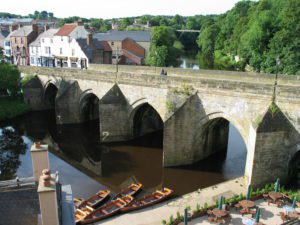Most people in Durham are familiar with Elvet Bridge, the beautiful medieval structure that spans the River Wear, linking Durham’s centre to the Elvet district. But there’s a lot more to its history than many of us know.
Construction work on the bridge started in 1160, under the command of Bishop Hugh de Puiset (1153-95). An influential Prince Bishop, Puiset instigated a large amount of building projects in England’s north. The bridge, however, took a long time to finish. It’s recorded, for example, that in 1228 the Church was still granting indulgences to people for helping to construct the bridge. (Indulgences were granted by the Catholic Church to reduce the amount of punishment people had to suffer for their sins.) Not so much has survived, however, of the earliest parts of the bridge. Only one of its arches dates from the 12th century. The others are 13th century.

Ten arches of the bridge can be seen, but many people over the years have suspected there are hidden arches. John Leland, an antiquarian active in the 1600s, claimed the bridge had no less than fourteen arches. Though no evidence has been found for this idea, it is very possible that some arches might be concealed below the street on the Elvet side or under Souter Peth.
The Wear normally flows through four of the bridge’s arches, but it can flow through more when river levels are high. It may also be the case that Elvet Bridge has the narrowest arches in Europe that it is possible for a person to row through.
In the past, there were buildings on the bridge. In the medieval period, the bridge was protected by towers and a fortified gate. The bridge also boasted two chapels: St James’s Chapel was found at its western end and St Andrew’s occupied its eastern end. But in 1632, St James’s Chapel was replaced by a prison! In the 1700s, the prison, or ‘house of correction’ as it was called, was demolished, along with quite a few other buildings that were clustered around the bridge. Part of St Andrew’s Chapel, however, has survived. You can see its remains from the Wear’s bank to the south. Another interesting part of the bridge’s past can also still be seen – grilles from the prison are visible in one of the bridge’s arches! Even today some buildings are partly built into the bridge. These include 18 Elvet Bridge, which is a grade one listed building.


The bridge has been repaired and restored a lot over time. Significant repairs went on between 1495 and 1501, under Bishop Foxe. The bridge’s three central arches had to be extensively renovated after a flood in 1771. In 1804-5, the bridge was widened to its current span of thirty-three feet.
Today the bridge is a grade one listed building and a scheduled ancient monument. We can see that for many centuries Durham’s townspeople have passed back and forth across Elvet Bridge. I wonder how many centuries it will continue to stand in the future.




























